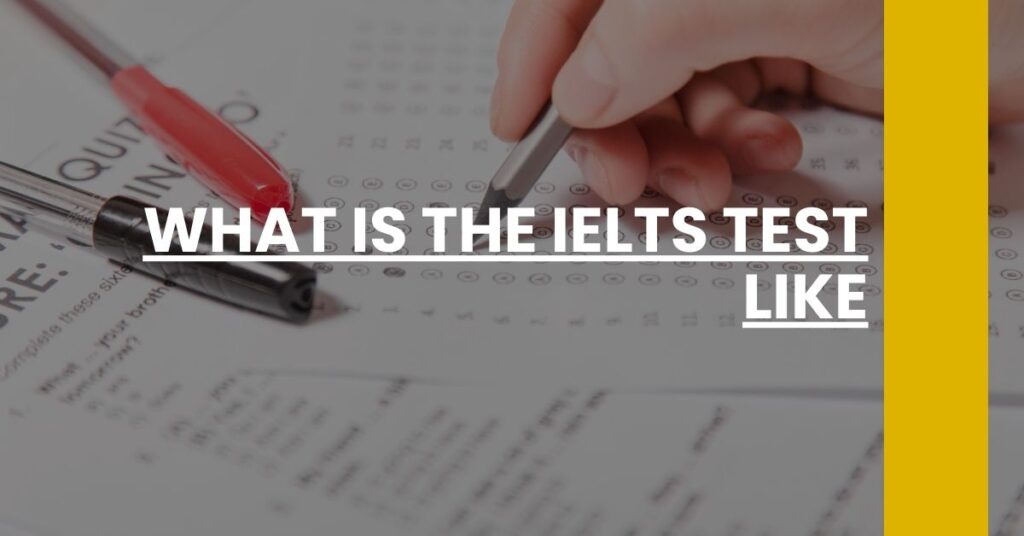The IELTS test is an English language proficiency exam taken by non-native speakers for immigration, academic, and professional purposes. It consists of four components: Listening, Reading, Writing, and Speaking. Test takers can expect a structured examination that assesses their English abilities in a variety of contexts, with results reported as band scores ranging from 0 to 9.
In this article, you’ll find crucial insights into:
- The distinct formats of the IELTS: Academic and General Training
- The specific time allotted for each section of the test
- Practical tips to prepare and succeed in the IELTS
If you’re gearing up to take the IELTS, this article outlines what to anticipate, ensuring you walk into your test with confidence and clarity.
- Understanding the IELTS Test
- Breakdown of the IELTS Test Formats
- A Closer Look at the IELTS Test Components
- Timing and Duration of the IELTS Test
- The IELTS Scoring System
- On the Day of the Test: What to Expect
- IELTS Test Preparation Tips
- Common Challenges and How to Overcome Them
- After Taking the IELTS: Results and Next Steps
- Conclusion: Embracing the IELTS Journey
Understanding the IELTS Test
The International English Language Testing System, known as IELTS, serves as a pivotal step for countless individuals aiming to achieve global educational, career, or immigration aspirations. Much like a compass guides an explorer, IELTS charts your course in English proficiency, providing an objective assessment that universities, employers, and immigration authorities trust.
Administered by luminaries in language assessment—the British Council, IDP: IELTS Australia, and Cambridge Assessment English—IELTS is the culmination of rigorous research and validation, ensuring every score tells an accurate story of a test-taker’s abilities. Your success in this test can open doors to international opportunities, signaling to the world that you have the linguistic finesse to thrive in an English-speaking environment.
For further details on the purpose of the IELTS and the organizations behind it, explore IELTS.org.
Breakdown of the IELTS Test Formats
Navigating the realms of IELTS begins with choosing the right path—Academic or General Training. Your expedition’s purpose will illuminate the way:
- IELTS Academic: This format rigorously assesses whether your English language prowess is fit for an academic environment. If university lecture halls or research labs are in your future, this is the beacon to follow.
- IELTS General Training: If your eyes are set on an English-speaking nation, not for study, but for the adventure of work or life’s journeys, General Training will prove your ability to survive and flourish in a broad social and workplace context.
The test’s ability to cater to distinct ambitions makes it not merely a test but a tailored experience in your academic or migration trajectory. For a deeper dive into which IELTS test is right for you, examine the specifics on the IELTS Australia website.
A Closer Look at the IELTS Test Components
The IELTS test is an expertly composed symphony played in four movements: Listening, Reading, Writing, and Speaking. Each segment is a testament to your English fluency, and familiarity with them is vital.
- Listening (30 minutes): The melodies of English greet your ears as you parse conversations and talks, gleaning details and broader contexts. It’s a auditory journey through different accents and audioscapes.
- Reading (60 minutes): Nuanced articles and complex texts form this section, inviting you to unravel implicit meanings, attitudes, and informational messages. Think of it as a treasure hunt through lines and paragraphs.
- Writing (60 minutes): Your chance to brandish the pen (or keyboard) and deliver articulate, well-structured responses to task-specific prompts. Whether arguing a point or explaining data, your words are a cascade of imagination and logic.
- Speaking (11-14 minutes): A fluent exchange with an examiner unmasks your ability to communicate effectively, revealing the spontaneity and clarity of your spoken English. It’s not just about correctness, but also about connection.
Twining through these sections with ease and confidence can greatly hinge on your understanding of what to expect. Break down the barriers to your success with the intricacies of each section available at IELTS Scoring in Detail.
Timing and Duration of the IELTS Test
As you embark on the IELTS journey, it’s pivotal to pace yourself. The total test time spans approximately 2 hours and 45 minutes, partitioned across the aforementioned components. Moreover, except for the Speaking part—which may be scheduled on the same day or within a week of the other sections—this expedition through English mastery unfolds in a single day. Consider this a marathon where economic pacing can be as crucial as depth of knowledge.
To embellish your time management strategies, arm yourself with more details on Cambridge English’s explanation of the test format.
The IELTS Scoring System
Navigating the IELTS scoring landscape can be as complex as understanding a new dialect. Each section of the IELTS is like a river contributing to the ocean of your overall band score—one that flows between 0 (“Did not attempt”) and 9 (“Expert user”). This score, your linguistic passport, reveals realms you can access; high stakes like university admissions and visa applications often hinge on these precious numbers.
You’ll find each skill—Listening, Reading, Writing, and Speaking—is evaluated independently, and these individual band scores are then averaged for your overall band score. Grasping the intricate scoring nuances enables you to target your preparations effectively.
For a comprehensive explanation of what constitutes a good score and how to interpret band scores, anchor yourself in Understanding Your IELTS Score.
On the Day of the Test: What to Expect
As the day of your IELTS assessment dawns, it’s essential to have a clear picture of what is the IELTS test like and how the day will unfold. The stringent security measures start with identification checks. Remember, the ID you used to register for the test should be on hand—typically a passport or national ID card.
Once inside the test center, the world outside fades away. The focus is on integrity and fairness, with strict rules in place to ensure every test-taker has an equal opportunity to perform their best. For instance, personal belongings are to be stored away, leaving you unencumbered to engage fully with the exam.
It’s also vital to note that all the test components, except the Speaking section, are typically completed in one sitting, with specified breaks between parts. Understanding the rhythm of the test day—the ebb and flow of check-in, testing, and breaks—can help you maintain a calm and focused demeanor throughout.
For a more comprehensive look at test day procedures and what to bring along, check About the IELTS Test.
IELTS Test Preparation Tips
Now, as you prepare for this linguistic voyage, consider that preparation is key—not only in understanding the material but also in acclimating to the test-taking environment.
Study Strategies:
- Practice Tests: Complete these under conditions that mirror the real exam to become comfortable with the time constraints and question types.
- Understand the Format: Acquaint yourself with the structure. Recognize the types of tasks you’ll encounter in each section and plan your approach.
- Engage with English: Increase your daily interaction with the language through books, movies, conversations, and more.
On Speaking and Listening:
- Focus on improving your pronunciation and fluency; they’re critical.
- In the Speaking section, your ability to communicate coherently and engagingly matters just as much as grammatical accuracy.
For a more detailed preparation guide, filled with test tips and strategies, drift over to IELTS Test Tips.
Common Challenges and How to Overcome Them
Common challenges on the IELTS often stem from time management, test anxiety, and linguistic pitfalls. To overcome them, ground yourself in routine practice—familiarity breeds confidence. Use practice tests to hone your pacing and accustom yourself to working within the time limits.
When test anxiety strikes, breathe. Remember that the IELTS is a reflection of your current English abilities, not a definitive measure of your worth or potential. Addressing linguistic weaknesses can be tackled by targeted practice, perhaps under the guidance of a tutor or study group.
Strategies to counter these obstacles are just as important as your study plan. For practical solutions tailored to the specifics of the IELTS test, consider diving into the wealth of information about the IELTS Format and Scoring Details.
After Taking the IELTS: Results and Next Steps
You’ve crossed the finish line—your IELTS test is complete. Expect the official results to be released some 13 days after the test date. These will be mailed to you but can often be accessed online as well. Your IELTS score remains valid for two years, serving as a passport to your next adventure.
If your score didn’t meet expectations, don’t lose heart. The path of language mastery is seldom straight. The IELTS can be retaken with no limit on attempts. Reflect, regroup, and when ready, you can face the test again with renewed insight and preparation.
For specifics on results and retake policies, a compass point to follow is the IELTS Results Page.
Conclusion: Embracing the IELTS Journey
By now, you should have a richly detailed map of what is the IELTS test like. From demystifying the test format to understanding scoring and preparation tips, this article aimed to illuminate the IELTS journey, preparing you for the rigor and rewards that this assessment harbors.
Whether pursuing academic heights, professional horizons, or personal milestones, your IELTS success is a testament to your English proficiency and a beacon for your future endeavors. Equip yourself with knowledge, craft a diligent preparation strategy, and approach the test with a mix of serenity and focus.
IELTS is not merely a test but a milestone on a grander quest for growth and global connectivity. Embrace the journey with an open heart and an eager mind, and let your IELTS adventure begin.
Discover what the IELTS test is like, its format, scoring, and preparation tips for success in this comprehensive guide.

